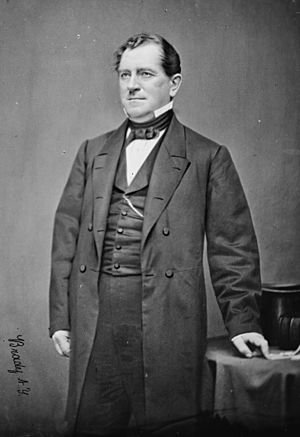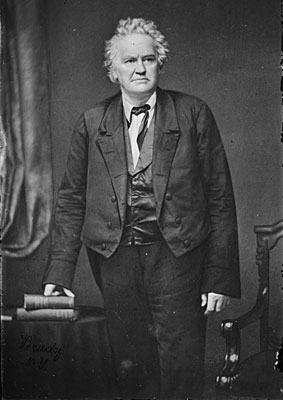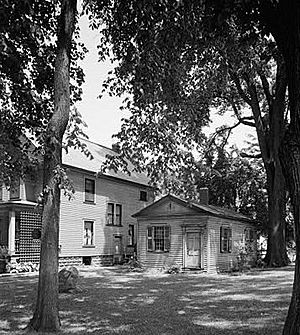Joshua Reed Giddings facts for kids
Quick facts for kids
Joshua Giddings
|
|
|---|---|

Photograph by Mathew Brady
|
|
| Dean of the United States House of Representatives | |
| In office March 4, 1855 – March 4, 1859 |
|
| Preceded by | Linn Boyd |
| Succeeded by | John S. Phelps |
| Member of the U.S. House of Representatives from Ohio |
|
| In office December 5, 1842 – March 3, 1859 |
|
| Preceded by | New district (20th district); prior to that represented Ohio's 16th district, which was dissolved. |
| Succeeded by | John Hutchins |
| Constituency | 16th district (1842–1843) 20th district (1843–1859) |
| In office December 3, 1838 – March 22, 1842 |
|
| Preceded by | Elisha Whittlesey |
| Succeeded by | Himself |
| Constituency | 16th district (1838–1842) |
| Member of the Ohio House of Representatives | |
| In office 1826–1827 |
|
| Personal details | |
| Born |
Joshua Reed Giddings
October 6, 1795 Tioga Point, Pennsylvania, U.S. |
| Died | May 27, 1864 (aged 68) Montreal, Canada |
| Political party | Democratic-Republican (before 1834) Whig (1834–1848) Free Soil (1848–1854) Opposition (1854–1856) Republican (1856–1864) |
| Signature | |
Joshua Reed Giddings (born October 6, 1795 – died May 27, 1864) was an American lawyer and politician. He was a strong opponent of slavery. Giddings represented Northeast Ohio in the U.S. House of Representatives from 1838 to 1859. He started as a member of the Whig Party and later helped create the Republican Party.
Giddings was known as a leading abolitionist, someone who wanted to end slavery. In 1842, he was officially criticized by the House of Representatives. This happened because he broke a rule called the Gag Rule, which stopped discussions about slavery. Giddings had proposed ideas against federal support for the coastwise slave trade after the Creole case. He resigned from his position but was quickly re-elected by a huge number of votes from people in Ohio. He returned to the House and served for almost twenty more years.
Giddings played a big part in making the Western Reserve area of Ohio one of the most anti-slavery places in the country before the American Civil War.
Contents
Early Life and Education
Joshua Reed Giddings was born in Bradford County, Pennsylvania, on October 6, 1795. His family moved to Canandaigua, New York, that same year. They lived there for ten years.
In 1806, his parents, Elizabeth and Joshua Giddings, moved the family to Ashtabula County, Ohio. This area was not very populated back then. They settled in Ohio's Western Reserve. Many people from New England moved there. This area was known for its strong beliefs, which might have inspired Giddings' passion against slavery.
Giddings first worked on his father's farm. Even though he didn't go to school much, he spent a lot of time studying and reading. When he was 17, he joined a militia (a group of citizens who act as soldiers) for the War of 1812. He served for five months and fought in battles against Native American allies of the British.
After 1814, Giddings became a schoolteacher. In 1819, he married Laura Waters. One of their children, Grotius Reed Giddings, became a Major in the American Civil War.
Giddings later studied law with Elisha Whittlesey to become an attorney. He also made some money by buying and selling land.
Legal and Political Career
In February 1821, Giddings became a lawyer in Ohio. He quickly became very busy, especially with criminal cases. From 1831 to 1837, he worked with Benjamin Wade, who later became a U.S. Senator. Both Giddings and Wade were influenced by Theodore Dwight Weld, an important anti-slavery speaker. They formed a local anti-slavery group together.
Giddings and Wade were both elected to Congress. They spoke out against slavery throughout their time in office.
Joining the Ohio and U.S. Houses
Giddings was first elected to the Ohio House of Representatives and served one term from 1826 to 1827.
After losing money in the Panic of 1837 (a financial crisis), Giddings stopped practicing law. He ran for a federal office and was elected to Congress. He was told to bring the issue of ending slavery to national attention. He was re-elected many times and served in the United States House of Representatives from December 1838 to March 1859. He represented different districts in Ohio during this time. Giddings changed political parties over the years, starting as a Whig, then a Free-soiler, then part of the Opposition Party, and finally a Republican.
Fighting Slavery in Congress
In 1841, Giddings and some other members of Congress, like Seth M. Gates and William Slade, formed a special group. They called themselves the Select Committee on Slavery. Their goal was to end slavery using any political methods they could. They even paid their own expenses to support their work. They were helped by Theodore Dwight Weld, who researched and wrote speeches for them. John Quincy Adams, a former President, was also a powerful ally.
Giddings found an early chance to speak out against slavery on February 9, 1841. He gave a speech about the Seminole War in Florida. He argued that this war was fought to protect slavery.
The Creole Case and the Gag Rule
A major event was the Creole case in 1841. American slaves on a ship called the Creole rebelled and forced the ship to go to Nassau, Bahamas. There, they became free because Britain had ended slavery in its territories in 1834. Slave owners in the Southern U.S. wanted the government to demand the return of the enslaved people or pay them for their "lost property."
Giddings argued that slavery was a state issue, meaning the federal government should not get involved. He believed that slavery only existed because of specific state laws. Because of this, he said that slavery in places controlled by the federal government, like the District of Columbia and U.S. territories, should be illegal. He also argued that the coastwise slave trade (shipping enslaved people along the U.S. coast) should be stopped because it was unconstitutional.
Giddings' statements in the Creole case got a lot of attention. He had broken the famous Gag Rule. This rule stopped members of Congress from discussing anti-slavery petitions. Former President John Quincy Adams led a fight in the House to get rid of this rule.
The U.S. government tried to get the enslaved people back from the Creole. Daniel Webster, who was the Secretary of State, said that since the enslaved people were on an American ship, they were under U.S. law and were considered property. But Britain said they were free people under British law.
On March 21, 1842, Giddings introduced a series of resolutions in the House. He stated that by gaining their freedom, the enslaved people had not broken any U.S. law. He argued that the U.S. should not try to get them back. For proposing these ideas, Giddings was strongly criticized. The House officially censured him (criticized him formally) for breaking the gag rule. They didn't even let him speak to defend himself.
Giddings then resigned from Congress. He asked the people he represented to vote for him again. They immediately re-elected him by a huge number of votes (7,469 to 383). This was the largest victory margin ever seen for a House seat at that time. After this, the House stopped trying to punish Giddings or his anti-slavery colleagues. Three years later, on December 3, 1844, the House finally got rid of the "gag rule."
Later Anti-Slavery Actions
Giddings' daughter, Lura Maria, was an active follower of William Lloyd Garrison, another important abolitionist. She encouraged her father to attend Garrison's meetings, which made his anti-slavery views even stronger. Giddings believed his anti-slavery feelings came from a "higher natural law," not just the Constitution. He strongly condemned the caning of Senator Charles Sumner in the Senate, calling it a crime against the Constitution and civilization.
Giddings used strong words to express his views. He spoke about the justice of enslaved people fighting for their freedom and the duty of Northerners to support such actions. He was against the Fugitive Slave Act of 1850, which required people to return escaped slaves. He advised escaped slaves to defend themselves if someone tried to capture them.
Giddings led the fight in Congress against allowing slavery to spread into new western territories. He spoke out against the annexation of Texas, the Mexican War, the Compromise of 1850, and the Kansas–Nebraska Act. All these actions could have led to slavery expanding. After the war with Mexico, Giddings was the only one to vote against thanking General Zachary Taylor.
Giddings moved from the Whig party to the Free Soil Party, which focused on stopping slavery's spread. In 1854–1855, he became one of the main founders of the Republican Party. Giddings supported John C. Frémont and Abraham Lincoln in their presidential campaigns. Before the Civil War, he helped the Underground Railroad, a secret network that helped enslaved people escape to freedom. He was known for his belief in equal rights for all races.
Before the Civil War, a newspaper in Virginia offered $10,000 to capture Giddings and send him to Richmond, or $5,000 just for his head.
In 1859, the Republican Party did not choose him to run for Congress again. Giddings retired after serving more than twenty years. In 1861, President Lincoln appointed him as the U.S. consul general (a diplomat) in Canada. He served there until his death in Montreal on May 27, 1864. He is buried in Oakdale Cemetery in Jefferson, Ohio.
Honors and Legacy
Joshua R. Giddings Elementary School in Washington, D.C., was built in 1887 and named after him. It is now a sports club.
His law office in Jefferson, Ohio, has been saved and is a National Historic Landmark.
A life-size bronze statue of Giddings is inside the Cuyahoga County Soldiers' and Sailors' Monument in Cleveland.
Published Works
- Speeches in Congress (1853)
- History of the Rebellion: Its Authors and Causes (1864)
Archival Material
The Indiana State Library has a collection of Giddings' letters and memories. This collection includes his memoirs, family letters (mostly between him and his daughter Laura), journal entries, Laura's diaries, photographs, and a biography written by his daughter.
See also
 In Spanish: Joshua Reed Giddings para niños
In Spanish: Joshua Reed Giddings para niños
- Joshua R. Giddings Law Office National Historic Landmark
- List of United States representatives expelled, censured, or reprimanded



